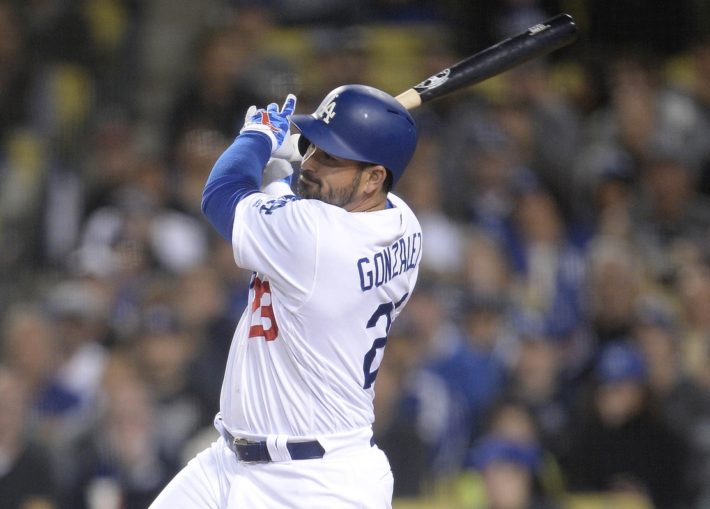There are 10 players eligible for induction into the Hall of Fame who have the Mets on some portion of their resume. Next up is one of the more consistent first basemen from the late 2000s to the mid-2010s who made Citi Field his last major-league home. He is making his first appearance on the Hall of Fame ballot.
There are players we refer to as Mets legends legitimately. There are players we jokingly call “Mets legends.” With all the respect given to Adrian González‘s career, one that is very respectable and includes five All-Star appearances, four Gold Gloves, and two Silver Sluggers, he is a “Mets legend.”
After a 2017 season that was plagued by a back injury, the 35-year-old made an attempt to extend his career by joining the Mets on the last year of his existing contract.
Starting at first base on Opening Day, he went 2-for-3 with a pair of walks and an RBI in a victory over the Cardinals. On April 8, he hit a grand slam in Washington. On April 29 against his former team, he went 3-for-6 and drove in five at Petco Park. González served the role of “veteran presence” and a placeholder for incoming youngsters on a club not yet ready for contention. On a personal note, he was able to reach the 2,000-hit milestone.
June 10 was the last time he played as a Met and, as it turned out, the last time he played in the major leagues. A day later, he was released.
Back in 2006, González was a San Deigo Padre and slashed .304/.362/.500 with 24 home runs and 82 RBIs in 156 games. Over the next four years, he would have three seasons of at least 30 homers, 100 RBIs, and an OPS+ above 126. The only season when that didn’t happen was 2009…when he had 99 RBIs.
He followed that stretch with arguably his best year. In 2011, his first season with the Boston Red Sox, González slashed .338/.410/.548 with 27 home runs and a league-leading 213 hits, driving in 117. It was one of seven times in which he hit at least 25 home runs. He also won his third Gold Glove and finished seventh in the MVP voting. His best result in the balloting was fourth the year before.
When at his best, González was a consistent and dependable first baseman. In 14-plus seasons, his slash line was .288/.358/.488 with 311 homers, 2,010 hits, 432 doubles, and 1,176 RBIs.
The Case For
There was a seven-year stretch (from 2008-14) when he was among the best at his position—able to hit for power, average, get on base, and field solidly.
It was during this span that he averaged 29 homers, 108 RBIs, and had an OPS+ of 138. He also made three of his All-Star appearances, collected all his Gold Gloves, and won both his Silver Slugger Awards.
One way to figure out if a player has a path to the Hall is to find a comparable player who’s already been enshrined. In González’s case, it might be Tony Perez.
Through their age-36 season (when Gonzalez retired), the numbers for Adrian come out favorable. Perez had a slash line of .284/.346/.477 with four fewer hits and 14 fewer home runs. Gonzalez also has the edge in walks (767 to 676), doubles (432 to 345), and total bases (3,399 to 3,301).
The Case Against
The comparison with Perez ends when you take into account that the former Cincinnati Red played an additional eight seasons. Longevity is one reason, among many, that significantly hurts González’s chances.
Other comparable careers include Derek Lee, who was off the Hall of Fame ballot after one try, and Tino Martinez, who got six votes in his lone turn.
González’s 317 homers rank 41st among first basemen. his 43.5 career WAR is 43rd-highest. Another metric to consider is JAWS, which measures a player’s Hall of Fame worthiness by averaging the player’s offensive or pitching WAR over a seven-year peak. The average JAWS metric of first basemen elected to the Hall of Fame is 53.4. Gonzalez is at 39.1.
Postseason performance is an opportunity to enhance a resume. Unfortunately, the numbers for González aren’t impressive: a slash line of .266/.329/.453 with seven home runs and 21 RBIs over 189 plate appearances.
Final Thoughts
Adrián González is a classic “Hall of Very Good” player. For about eight years, his level of play was worthy of All-Star recognition. But for him to be elevated to Cooperstown-level status, he needed to either sustain his best level longer or have more production in those eight years. He should remain on the ballot, but he is not a Hall of Fame player.
As of publishing, he doesn’t have a single vote for the Hall among publicly available ballots.
















